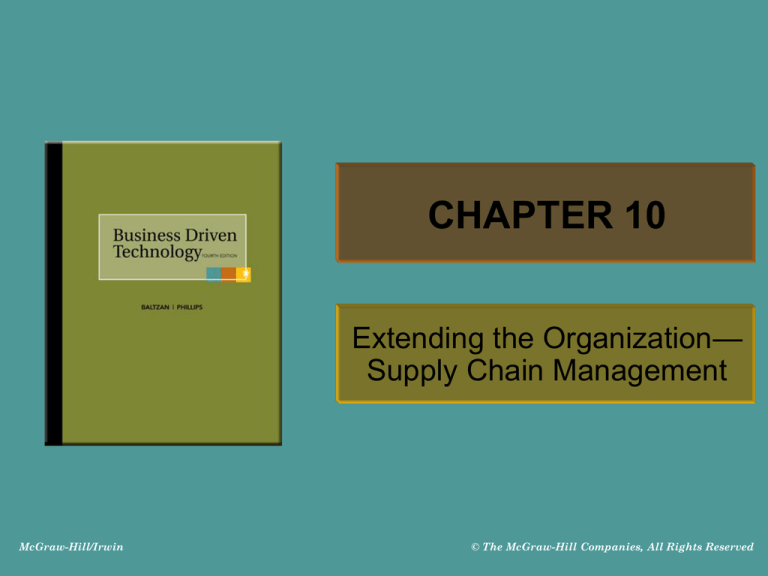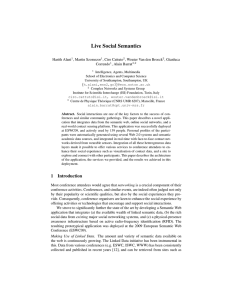
CHAPTER 10
Extending the Organization—
Supply Chain Management
McGraw-Hill/Irwin
© The McGraw-Hill Companies, All Rights Reserved
LEARNING OUTCOMES
10.1 List and describe the components of a typical
supply chain
10.2 Define the relationship between decision
making and supply chain management
10.3 Describe the four changes resulting from advances in IT
that are driving supply chains
10.4 Summarize the best practices for implementing a
successful supply chain management system
10-2
SUPPLY CHAIN MANAGEMENT
• The average company spends nearly half
of every dollar that it earns on production
• In the past, companies focused primarily
on manufacturing and quality
improvements to influence their supply
chains
10-3
BASICS OF SUPPLY CHAIN
•
The supply chain has three main links:
1. Materials flow from suppliers and their
“upstream” suppliers at all levels
2. Transformation of materials into semifinished
and finished products through the
organization’s own production process
3. Distribution of products to customers and
their “downstream” customers at all levels
10-4
BASICS OF SUPPLY CHAIN
• Organizations must embrace technologies
that can effectively manage supply chains
10-5
BASICS OF SUPPLY CHAIN
10-6
INFORMATION TECHNOLOGY’S
ROLE IN THE SUPPLY CHAIN
• IT’s primary role is to create integrations or tight process and
information linkages between functions within a firm
10-7
INFORMATION TECHNOLOGY’S
ROLE IN THE SUPPLY CHAIN
• Factors Driving SCM
10-8
Visibility
• Supply chain visibility – the ability to
view all areas up and down the supply
chain
• Bullwhip effect – occurs when distorted
product demand information passes from
one entity to the next throughout the
supply chain
10-9
Consumer Behavior
• Companies can respond faster and more
effectively to consumer demands through
supply chain enhances
• Demand planning software – generates
demand forecasts using statistical tools
and forecasting techniques
10-10
Competition
• Supply chain planning (SCP) software–
uses advanced mathematical algorithms to
improve the flow and efficiency of the supply
chain
• Supply chain execution (SCE) software –
automates the different steps and stages of
the supply chain
10-11
Competition
• SCP and SCE in the supply chain
10-12
Speed
• Three factors fostering speed
10-13
SUPPLY CHAIN MANAGEMENT
SUCCESS FACTORS
10-14
SUPPLY CHAIN MANAGEMENT
SUCCESS FACTORS
•
SCM industry best practices include:
1. Make the sale to suppliers
2. Wean employees off traditional business
practices
3. Ensure the SCM system supports the
organizational goals
4. Deploy in incremental phases and measure
and communicate success
5. Be future oriented
10-15
SCM SUCCESS STORIES
• Top reasons why more and more executives are turning to
SCM to manage their extended enterprises
10-16
SCM SUCCESS STORIES
• Numerous decision support systems (DSSs) are
being built to assist decision makers in the design
and operation of integrated supply chains
• DSSs allow managers to examine performance
and relationships over the supply chain and
among:
–
–
–
–
Suppliers
Manufacturers
Distributors
Other factors that optimize supply chain performance 10-17
SCM SUCCESS STORIES
10-18
OPENING CASE STUDY QUESTIONS
SecondLife
1. Would you need supply chain management
systems in a virtual world such as Second Life?
Why or why not?
2. How could a real company augment its supply
chain management system through Second Life?
3. If you were an apparel company, such as Nike or
REI, what would your virtual SCM system look
like? Create a drawing of this system and be
sure to include all upstream and downstream
participants?
10-19
CHAPTER TEN CASE
RFID – Future Tracking
1. What are some advantages and
disadvantages of tagging students with RFID
tags?
2. What are some advantages and
disadvantages of tagging children’s pajamas
with RFID tags?
3. Do you agree or disagree that tagging
students with RFID tags is a violation of
privacy rights? Explain why
10-20
CHAPTER TEN CASE
RFID – Future Tracking
4. Do you agree or disagree that tagging
children’s pajamas with RFID tags is a
violation of privacy rights? Explain why
5. Describe the relationship between privacy
rights and RFID
6. Determine a way that schools could use RFID
tags without violating privacy rights
10-21











